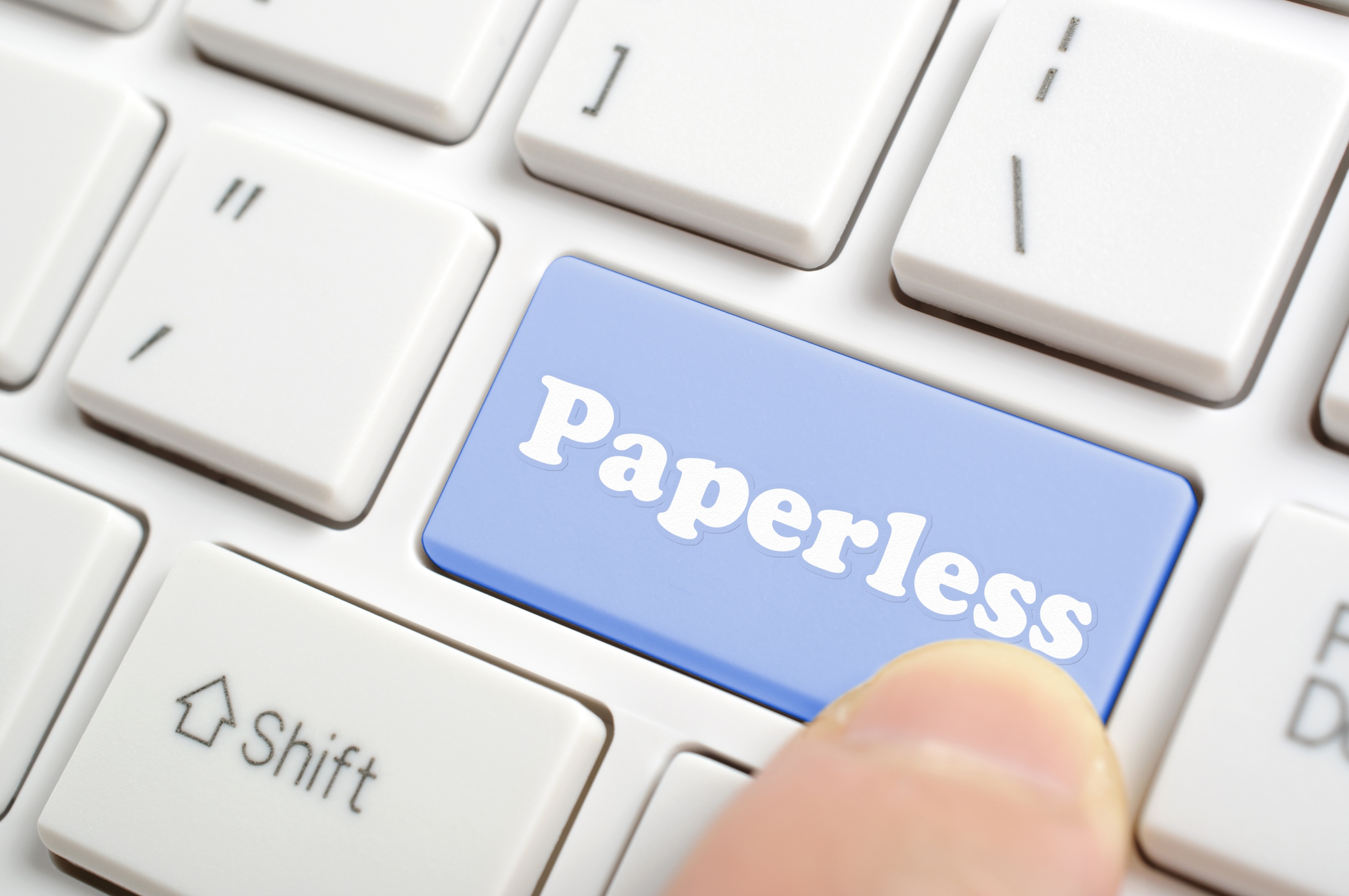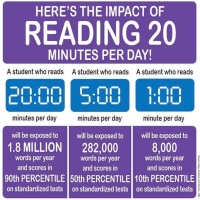5 benefits of going paperless.

I love the planet; however, I didn’t go paperless in my classroom to save the Earth. It’s a fabulous, additional benefit, as we ELA teachers can photocopy like nobody’s business! But saving trees wasn’t the motivating force two years ago; engaging my students–while trying to work smarter and not harder–was.
First, some background. I teach in a BYOD (Bring Your Own Device) high school, so, on any given day, our students are working on iPads, Chromebooks, Kindles, cell phones, MacBooks, Surface Tablets, and/or Windows laptops. Because our district is a GAFE (Google Apps For Education) community, our students have school-issued Gmail accounts, and many teachers use Google Classroom as our content-delivery platform. Students use their device of preference and the school’s WiFi to access the teacher’s content. However, regardless of one’s environment, using the internet to deliver at last part of the content has countless benefits. Here are five reasons to consider going paperless tomorrow.
1. YOU CAN SLEEP IN (-ish). Since I now push out class handouts, create activities, and share websites digitally, I no longer have to beat my colleagues to the photocopier. Which may or may not be working. Before going paperless, Murphy’s Hughes’ Law dictated that a class set of 25 handouts would mirror a hostage negotiation. (“You seem frustrated; on the count of three, slowly back away from the master copy, and I promise to stop chewing and spitting out uour copies.”) While the LBD (Little Black Dress) is always en vogue, LBTE (Lots o’ Black Toner–Everywhere) is never in style–whether on one’s hands, face, or even backside. (The latter of which one might not discover until the end of the day–hypothetically speaking.)
I said “-ish” because the paperless teacher can’t really sleep in. The time at the copier is traded for time on the computer, getting documents ready for delivery, culling good sources to share with the students, and organizing it all in a post with clear directions. (Aside: The teacher is still extremely vital in the paperless classroom; however, the sage on the stage has been replaced with the facilitator, as the teacher moves from group to group to check for understanding.)
2. ABSENTEES DON’T LOSE MOMENTUM. When students are absent, they can check the designated space online* and complete the missed classwork without skipping a beat. Momentum is maintained, and upon their return, absentees no longer need to ask, “What did I miss yesterday?” In a recent survey, one of my students reflected on it this way:
When I am absent from school or cannot come to class, I can get all my work, do it at home, and not fall behind! Having everything online means I can receive all assignments, even if I am not in class.
* NOTE: Everyone’s system is different; however, I create live calendars in a Google doc every two weeks, which are posted in the ABOUT section in Google Classroom for easy access. My calendars include hyperlinks to documents I have shared in Classroom and/or Drive, sites we will be exploring together, video clips the students will watch, etc.) We start each class with ten delicious minutes of silent reading and then “meet up” in the biweekly calendar to review the current day’s plan, that night’s homework, and see how both fit into the big picture.
3. TEACHERS CREATE AN EVEN PLAYING FIELD. Every cl ass includes students ranging from mildly disorganized to those living with Executive Functioning Disorder (EFD). In a paperless classroom, gone are the days when Struggling Susie reaches into her backpack and pulls out 29 (crumpled) handouts when the teacher has asked for Handout #30. (This is usually followed by the organizational aficionado jabbing, “Dude, you totally need to clean out that backpack!” Really?) One of my sophomores framed it perfectly:
ass includes students ranging from mildly disorganized to those living with Executive Functioning Disorder (EFD). In a paperless classroom, gone are the days when Struggling Susie reaches into her backpack and pulls out 29 (crumpled) handouts when the teacher has asked for Handout #30. (This is usually followed by the organizational aficionado jabbing, “Dude, you totally need to clean out that backpack!” Really?) One of my sophomores framed it perfectly:
As a student with ADD, it is infinitely easier to keep organized in a digital classroom. This is because I am in the digital native generation- organizing a computer comes much more easily and naturally to me than organizing a backpack. It’s not a coincidence that the paper-based classes I’m in are the grades that fluctuate the most. The grades I get in a more digital classroom tend to stay much more consistent.
4. STUDENTS & TEACHERS CAN WORK ASYNCHRONOUSLY. With the curriculum posted online, students can access it at a time that is convenient for them. This is great news for the first-block-of-the-day students who could benefit from a second review later in the day, when it is better for their brains. While the mother in me cringes, it is not uncommon for students to post work at 1 AM. However, as long as my students meet the deadline, I can’t impose my own schedule on them. After all, I do my best work between the hours of 4 and 6 AM when my students wouldn’t dream of doing homework. One of my students captured the asynchronous feature of the paperless classroom beautifully:
Being paperless in the classroom means anything we do in class will be with me when I go home. This adds to the convenience of being able to go back and look at everything I need all in one place as opposed to on multiple different sheets of paper per night. It also helps to keep organization up and to ensure that I will have what I need for class every day.
5. STUDENTS & TEACHERS LEARN THE ART OF FLEXIBILITY. Technology is a fabulous tool. When it works. On more than one occasion, I’ve invested countless hours in a lesson–only for technology to take its ball and go home. Veteran teacher or not, having our plans thwarted can be rattling. (“The best-laid schemes of mice and men…“) However, when things don’t work, when lessons flop, when technology seems out to get us, that’s when it really counts. One of my favorite quotes is from Pastor Dwight L. Moody: “Character is what you are in the dark.” And whether we teachers are literally in the dark (power outage, anyone?) or figuratively, our students benefit from seeing that character of flexibility in us. It might not be part of the Common Core State Standards, but flexibility is one of the most important, real-world skills our students will need long after they leave our classroom.
There are a myriad of other benefits of teaching in a paperless classroom; however, a class set of digitally submitted essays await! If you need more convincing, I leave you with a response from one of my juniors:
Compared to normal classes, a paperless class has benefited me in many ways. For one thing, I am very much into saving paper and conserving in general! Go green or go home! Also, being online allows me to not carry around as many things that would weigh down my backpack. Usually for each class, I have to have a notebook and or folder, and I lose papers much of the time. This way, everything is stored on my laptop. Also, it is easier for me when I go to do my homework because I do not have to remember to bring items home. Most of all, being paperless helps my back problems!! LOL







jlrowse, that makes me so sad. I feel like I have the opposite problem, where being connected can be 24/7 if we allow it to be. I struggle setting boundaries, like only responding to students during the hours of X and Y. Otherwise, I’m missing out on my own two kids’ lives by responding to the 30+ student emails I get on any given day. The instant gratification has taken its toll on teaching in many respects.
Do your students not do HW then, because you shouldn’t expect them to when school isn’t in session?
I know teachers who post new, unannounced assignments and quiz notifications (not reminders) outside of school hours, expecting students to check for new assignments that might pop up. The student who finishes HW by 6 PM isn’t going to look for an assignment posted at, say, 8:30 PM.
I do enjoy Classroom, and my students seem to like that many of us are using it. I think it gets muddled, is counterproductive, and works against us when students are expected to learn–and operate successfully within–3-5 different platforms on any given day. That might make me resent technology, too.
LikeLike
Wow! Great to find a post with such a clear mesgesa!
LikeLike
Great post, Beth!
If I were to add anything to the ever growing benefits of a paperless classroom, it would be the incredible real-time feedback I’m able to provide to students. Feedback after a submission is often forgotten if the grade is already tacked on, but before?! It’s meaningful and a chance to improve! What’s more is that as a school librarian, I have limited opportunities to provide direct student feedback. But coteaching with teachers who use Google Classroom means that I’m able to provide feedback on a student’s sources and direct quotes while the ELA teacher can comment on their syntax. It’s a beautiful thing! And I’m so thankful for the student connection is affords me.
Thanks for sharing! 🙂
LikeLiked by 1 person
So true, Erin!
LikeLike
Any tips for how you get kids to utilize the online spaces when they are absent, or to work asynchronously? I’ve been using Google Classroom since its release, and I keep a calendar/daily agenda as well, and students don’t use any of it. I have to remind them it is there, even though we use it in class every day.
LikeLiked by 1 person
Thanks for stopping by, Jlrowse! What grade level do you teach? I teach at the HS level, which could be part of the difference. There was definitely a learning curve, as well as a gradual release. I had to double-up (quadruple up?) on the reminders at first, but then they started to get it. I still have to follow our school’s make-up work policy, which states that students have a full, 6-day cycle to make up work. However, more students do the work while home, as it’s easier than having double the work when they return. It’s not perfect, but it’s definitely better than it was.
LikeLike
I teach juniors and seniors. I remind them constantly, and during a unit of study about the Internet this semester, I asked them if they use teacher websites/schoology/Google Classroom in their other classes. Resounding no. So I asked why. Overwhelmingly: “school only happens between 7:45 and 3:20. If we’re not here, we shouldn’t be expected to do the work until we return. And we have lives that start at 3:30, with no room for school.” Even my high-achievers don’t utilize the online resources I provide.
I remind them constantly, and during a unit of study about the Internet this semester, I asked them if they use teacher websites/schoology/Google Classroom in their other classes. Resounding no. So I asked why. Overwhelmingly: “school only happens between 7:45 and 3:20. If we’re not here, we shouldn’t be expected to do the work until we return. And we have lives that start at 3:30, with no room for school.” Even my high-achievers don’t utilize the online resources I provide.
I’m still planning on using Google Classroom, but every year I encounter more and more students resistant to technology (can’t count how many times I heard “I hate technology” this semester) and I don’t know if it’s this particular group of kids, or pushback from a generation that is overloaded with tech. It’s hard to say, but it’s definitely making me think more critically about the benefits of going paperless (which was my goal 6 years ago). I’m hoping next year will be better.
LikeLiked by 1 person